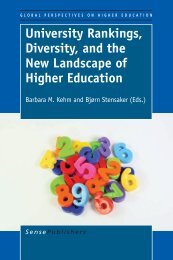Rupturing Concepts of Disability and Inclusion
Rupturing Concepts of Disability and Inclusion
Rupturing Concepts of Disability and Inclusion
You also want an ePaper? Increase the reach of your titles
YUMPU automatically turns print PDFs into web optimized ePapers that Google loves.
2.5.4 Constructing A ‘Research Quilt’<br />
CONCEIVING A QUILT: CREATING A METHOD<br />
Although a design has been indicated, numerous steps are required to prepare the<br />
top layer.<br />
Firstly, there is the choice <strong>of</strong> fragments, which considers the particular textures<br />
<strong>of</strong> the fabrics. What constitutes the threads <strong>of</strong> disability theories <strong>and</strong> practices,<br />
how implicit values act, what is influenced by the controlling ethics, <strong>and</strong> how<br />
boundaries constrain <strong>and</strong> define are necessary textual considerations. These will be<br />
explored in Part Two <strong>of</strong> this research.<br />
After considering the texture, the second step is to consider how the fragments<br />
may be patterned according to ethical frameworks or ethical templates <strong>of</strong><br />
underst<strong>and</strong>ing.<br />
Ethical discourses such as bioethics <strong>and</strong> rights are prevalent in the disability<br />
context. However, decisions need to be made as to whether these are the most<br />
appropriate templates by which to explore <strong>and</strong> ethically signify inclusion, <strong>and</strong> if<br />
not, then to <strong>of</strong>fer an alternative framework. This exploration occurs in Part Three.<br />
Having chosen an appropriate framework, the third step is to lay out the<br />
patterned fragments <strong>of</strong> Pr<strong>of</strong>ound Exclusion, Technical <strong>Inclusion</strong> <strong>and</strong> Legislative<br />
<strong>Inclusion</strong>. These are fragments which also contain ethical ambivalences that need<br />
to be identified. Using the same framework for patterning, then, the form <strong>of</strong> Ethical<br />
<strong>Inclusion</strong> can be contemplated. However, it will be shown that Ethical <strong>Inclusion</strong><br />
not only has a different texture, but is embedded in a different socio-ethical fabric.<br />
‘A Transformatory Ethic <strong>of</strong> <strong>Inclusion</strong>’ is conceived as an instrument <strong>of</strong> rupture<br />
by which the notion <strong>of</strong> integrality can be conceptualised, <strong>and</strong> ethically defended.<br />
This third exploration occurs in Part Four <strong>of</strong> this research.<br />
After these steps, the top layer is prepared.<br />
2.6 SUMMARY<br />
In this chapter, I have attended to two objectives. Firstly, I have introduced an<br />
exploration <strong>of</strong> the conceptualisation <strong>and</strong> ethical significance <strong>of</strong> the notion <strong>of</strong><br />
inclusion in relation to people who are marginalised in Western Judeo-Christian<br />
society, particularly people with intellectual disability. Secondly, I have developed<br />
a methodology by which to adequately explore the topic.<br />
I have indicated how so called ‘care’ for disabled people in a post-Enlightenment<br />
<strong>and</strong> post-industrial Western Judeo-Christian society has predominantly been provided<br />
in segregated contexts, <strong>of</strong>ten resulting in physical placement in institutions. Recent<br />
developments in disability policies <strong>and</strong> practices challenge such exclusionary<br />
practices to promote deinstitutionalisation <strong>and</strong> inclusion. However, I suggest that it<br />
would be futile to continue to shape inclusion policies <strong>and</strong> practices without giving<br />
due attention to redefining the structures <strong>of</strong> signification, that is, the frameworks <strong>of</strong><br />
meaning <strong>and</strong> valuation where the momentum <strong>of</strong> hidden ontological <strong>and</strong> epistemological<br />
assumptions keeps people with intellectual disability in particular socioethical<br />
positions within Judeo-Christian subcultures.<br />
Therefore, I highlight the significance <strong>of</strong> purposefully choosing Judeo-Christian<br />
society for exploration, because, I argue, such a context serves not only as an<br />
35














